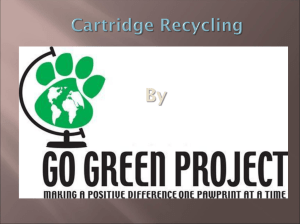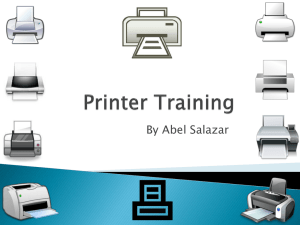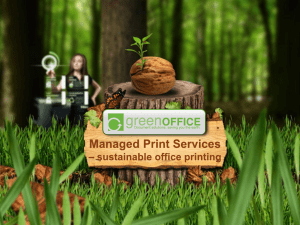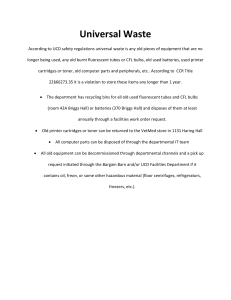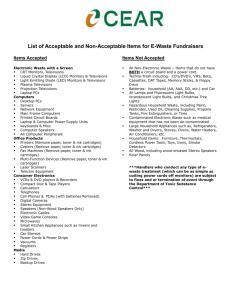Business Solutions Association Print Cartridge Classes, Definitions
advertisement
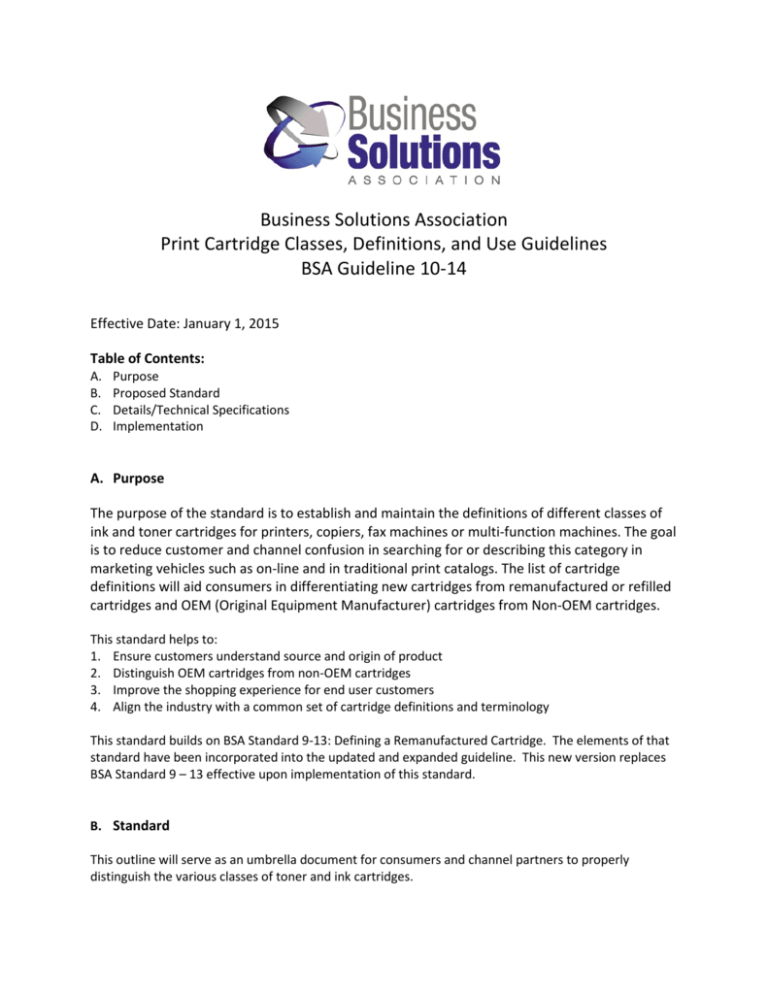
Business Solutions Association Print Cartridge Classes, Definitions, and Use Guidelines BSA Guideline 10-14 Effective Date: January 1, 2015 Table of Contents: A. B. C. D. Purpose Proposed Standard Details/Technical Specifications Implementation A. Purpose The purpose of the standard is to establish and maintain the definitions of different classes of ink and toner cartridges for printers, copiers, fax machines or multi-function machines. The goal is to reduce customer and channel confusion in searching for or describing this category in marketing vehicles such as on-line and in traditional print catalogs. The list of cartridge definitions will aid consumers in differentiating new cartridges from remanufactured or refilled cartridges and OEM (Original Equipment Manufacturer) cartridges from Non-OEM cartridges. This standard helps to: 1. Ensure customers understand source and origin of product 2. Distinguish OEM cartridges from non-OEM cartridges 3. Improve the shopping experience for end user customers 4. Align the industry with a common set of cartridge definitions and terminology This standard builds on BSA Standard 9-13: Defining a Remanufactured Cartridge. The elements of that standard have been incorporated into the updated and expanded guideline. This new version replaces BSA Standard 9 – 13 effective upon implementation of this standard. B. Standard This outline will serve as an umbrella document for consumers and channel partners to properly distinguish the various classes of toner and ink cartridges. In addition to the primary recommended term, included in the definitions are a list of “other terms” and “terms to be avoided” by consumers and the industry. This standard is not intended to limit the use of any terms as part of a product or service brand name that communicates the product's or service's brand affiliation. Additionally, it is not meant to restrict use of words within the text of marketing materials where those terms are used in the course of normal application. Examples of acceptable use include: • This cartridge is intended to replace cartridges manufactured by XY brand. • Cartridge X is compatible with Printer Y. • The photo black cartridge is not a substitute for the black cartridge. C. Details/Technical Specifications New Cartridge Classes and Definitions for Cartridges OEM (Original A new cartridge that is designed, manufactured and/or distributed by the Equipment manufacturer of the printer in which the cartridge is intended to be used. Manufacturer) An OEM cartridge may contain recycled parts. Other terms: Original, Genuine, New OEM, Original OEM, no specified classification. Note that lack of classification is usually assumed by customers to be OEM. Non-OEM New Build Terms to avoid as class reference for OEM: None identified A new cartridge with a shell, internal components and ink or toner that is produced by a company NOT affiliated with the printer hardware manufacturer of the printer in which the cartridge is intended to be used. These cartridges may or may not infringe on intellectual property rights and intellectual property protection may change at any time. If intellectual property status of a Non-OEM New Build cartridge is unclear, it is recommended that resellers check with the manufacturer, distributor, and/or legal counsel. Other terms: Aftermarket New Build, Non-OEM New, Third-party New, Third-party New Build Terms to avoid as class reference for Non-OEM New Build: Compatible, Clone, New Build Compatible, Substitute, Replacement Compatible: This term can apply to all cartridges and is too general to help the customer understand the source and origin of the product. Clone: Sometimes used as an alternative term for a compatible cartridge, Clone generally infers that the product is a direct copy of an OEM design without regard to intellectual property infringement that may occur from manufacturing and/or sale. Substitute/Replacement: This term is too general to help the customer understand the type of product offered because substitute/replacement can fall into any of the non-OEM categories referenced in this document (remanufactured, alternative new or refilled). Previously Used Cartridge Classes and Definitions Remanufactured A cartridge that has been previously used, the marking substance consumed, and then is subsequently collected, inspected, cleaned, had new or reconditioned parts installed, refilled with ink or toner, and tested so that its capability to print has been restored. This previously used cartridge could be either an OEM or a non-OEM cartridge. If intellectual property status of a remanufactured cartridge is unclear, it is recommended that resellers check with the manufacturer, distributor, and/or legal counsel. As examples: 1) For compliance to the First Sale Doctrine, the original and empty OEM cartridge must have been collected from first users in the United States. 2) The remanufacturer should remove OEM trademarks or logos from the cartridge. However, if removal would compromise the performance of the product, then complete removal may not be required. In those cases, it would be sufficient if the remanufacturer fully covers the OEM trademark or logo so that it is not visible. Other terms: None identified Terms to avoid as a class reference for Remanufactured: Replacement, substitute, reconditioned, refurbished, rebuilt, compatible, new compatible, newly remanufactured, newly manufactured, newly built, newly refreshed, new build, new plastic, factory fresh, OEM compatible. New: By definition, remanufactured products are not new. Replacement/Substitute: Replacement/substitute cartridges can fall into any of the non-OEM categories referenced in this document (remanufactured, alternative new or refilled). This term is too general to help the customer understand the source and origin of the product. Refurbished: Refurbished should only be used to describe a product originally sold, returned to the original printer manufacturer prior to substantial use, then restored by the manufacturer to a condition identical to a newly manufactured and unsold good and then resold under its original branding. This does match the definition of remanufacturing. Refilled A cartridge that is refilled with non-OEM ink or toner and resealed. Some components may be replaced, but the principal service is replacing the marking substance in a cartridge supplied by the customer. The process may be performed by a technician in a local store, or by the customer using commercially available supplies. This previously used cartridge could be either an OEM or a non-OEM cartridge. Sub-categories: a) Drill and fill: A type of cartridge refilling where a hole is made in the outer casing of the cartridge through which the cartridge is refilled with Non-OEM ink or toner. The hole is plugged and the cartridge returned to the customer. b) Refill kit: A do-it-yourself kit that includes non-OEM ink or toner, along with tools and instructions for refilling. c) Refill appliance: A small refilling appliance or station intended for consumer use that automates or semiautomates the refilling process using Non-OEM ink or toner. d) Refill kiosk: A stand-alone shop, kiosk or in-store retail location where customers can have used cartridges refilled with non-OEM ink or toner. These locations are staffed with employees that will refill the cartridge while the customer waits. Other terms: None identified Terms to avoid as a class reference for Refilled: Compatible, Refurbished, Replacement, Substitute Compatible: This term can apply to all cartridges and is too general to help the customer understand the source and origin of the product. Refurbished: Refurbished should only be used to describe a product originally sold, returned to the original printer manufacturer prior to substantial use, then restored by the manufacturer to a condition identical to a newly manufactured and unsold good and then resold under its original branding. This does match the definition of remanufacturing. Replacement/substitute: Replacement/substitute cartridges can fall into any of the non-OEM categories referenced in this document (remanufactured, alternative new or refilled). This term is too general to help the customer understand the source and origin of the product. Other Refurbished Counterfeit Specialty/Industrial Applications, including MICR A cartridge originally sold, returned to the original printer manufacturer prior to substantial use, then restored by the manufacturer to a condition identical to a newly manufactured and unsold good. The product is then resold under its original branding. This term should NOT be used to describe cartridge remanufacturing or refilling. A cartridge that is labeled, packaged and passed-off in such a way that is intended to mislead a customer into thinking it is an OEM product. Counterfeit cartridges could be produced from remanufactured, refilled or alternative new cartridges. In addition to other potential legal claims, counterfeit cartridges violate OEM trademarks. Counterfeiting print cartridges is a criminal activity. Counterfeit products that use alternative new cartridges could also give rise to claims of patent infringement. The print cartridge classes, definition and naming standards and definitions described above are applicable to print cartridges intended for general business and home printing use. The naming standards are not intended to apply to special purpose print cartridges including Magnetic Ink Character Recognition (MICR) print cartridges (described below) or those intended for industrial applications. MICR Toner Magnetic Ink Character Recognition (MICR) is a character recognition technology used mainly by the banking industry to ease the processing and clearance of checks and other documents. The MICR encoding, called the MICR line, is at the bottom of checks and other vouchers and typically includes the document type indicator, bank code, bank account number, check number, check amount and a control indicator. The technology allows MICR readers to scan and read the information directly into a data-collection device. a) Remanufactured MICR Toner Cartridge: An OEM cartridge that has already been used is collected, inspected, and cleaned, had new or reconditioned parts installed, and then is filled with MICR toner. This type should be referred to as [Brand] Remanufactured MICR Toner Cartridges. b) New MICR Toner Cartridges A new, never used OEM cartridge that has been emptied of OEM toner and refilled with MICR toner. These brand-new cartridges contain all original components and are then filled with MICR toner. This type should be referred to as [Brand] New MICR Toner Cartridges. The tables below outline the elements, word order and application of the product classes for use when describing a print cartridge: Product Title Element OEM Brand Cartridge Class Cartridge model Cartridge color Cartridge type Cartridge size/yield Number in pack SKU Description/Examples Name of the company that originally sold the product (e.g. ,HP, Xerox, Lexmark, Brother) Name of the company affiliated with the non-OEM brand cartridge being sold (e.g., Staples, Office Depot, OfficeMax, Innovera) Class of cartridge as previously identified: OEM, Original, Remanufactured, Alternative New or Refilled Specific model number or SKU (e.g., #70, TN630, CB435A) Black, cyan, magenta, yellow, tri-color, photo, etc. Toner cartridge, ink cartridge, inkjet print cartridge, etc. May be expressed as a description (e.g., standard yield, high yield, high capacity), an alpha designator (e.g., A, X, XL) or by the number determined by a widely accepted standard of yield testing. Reference for number or type of multipack offered, e.g., 2-pack, 3pack, twin pack, combo pack, multipack. Stock Keeping Unit, e.g., CB435A Product Title/Naming Treatment Product title and/or name should be a clear statement concerning the product sold according to the classes of product identified above. Product Title New OEM ink or toner cartridge [OEM brand] + [cartridge model] + [VC: cartridge class, size] + [cartridge color] + [cartridge type] Where [VC] = variable content, to be added or omitted from the listing definitions identified in this document to produce a clear product listing. Additional information such as [# pack], [SKU], or [supported printers] can be added. Remanufactured, Refilled, NonOEM New Build ink or toner cartridge Examples of the recommended naming structure: • HP 05X High Yield Black Original LaserJet Toner Cartridge • HP 951 Cyan Original Ink Cartridge • Lexmark 801SK Black Standard Yield Return Program Toner Cartridge • Lexmark 105XL Black High Yield Return Program Ink Cartridge • Brother TN350 Toner Cartridge The governing rule for Remanufactured, Refilled, Non-OEM New Build cartridge names is that the following elements are fixed and variable, allowing some flexibility with product naming while still adhering to a consistent theme: [Brand] + [cartridge class] + [VC: cartridge size/color] + [cartridge type] + “alternative for” + [OEM brand] + [VC] Where [VC] = variable content, to be added or omitted from the listing definitions identified in this document to produce a clear product listing. Additional information such as [# pack] can be added. If the product sold has “no brand” – e.g., the product is delivered in generic packaging or sold with no associated brand, then “brand” may be substituted in the product title with ‘Generic’. Examples of the recommended naming structure: • Elite Image Remanufactured Toner Cartridge alternative for Lexmark T640/42/44 High-yield • Generic brand Non-OEM New Build Toner Cartridge alternative for HP 05a Note: If character count is a concern, variable content should be the first content to be abbreviated or removed. In the event that the full product name is or will still be truncated as a result of character count limitations, the word alternative may be shortened to “alt.” so that the rest of the product name elements display correctly and clearly for the end user. D. Testing Ink and toner cartridges are marketed with a wide variety of claims regarding technical specifications or performance attributes. Such claims should be backed by testing reports and data, either in-house or by reputable third parties that possess a credible basis for testing, authenticating and substantiating the claimed specification or performance attribute. Buyers should ask for documentation regarding claims and carefully scrutinize those materials to be sure they come from a credible source and support the claimed specification or performance attribute. E. Implementation Implementation of the guidelines for Print Cartridge Classes & Definition Guidelines will commence on January 1, 2015, or sooner and will be unveiled at the 2014 BSA Forum in October 2014. Reference Materials: 1. 2. 3. 4. Defining a Remanufactured Cartridge. BSA Standard 9 – 2013 (retired upon implementation of this standard). I-ITC Clone Resolution, 1-23-13.pdf. Imaging Technology Council (ITC) Resolution regarding the New, Clone cartridges. Toner Conference PowerPoint by Tricia Judge – I-ITC, 6-3-12. Comprehensive presentation about Counterfeiting & Compatible Cartridges. HP vs. LD Products, 2-4-13.pdf. HP Legal Complaint filed in California against LD Products Inc. (17 pages).
